Classical Civilisation > AS Mark Scheme > GCE Classical Civilisation H408/33: Politics of the Late Republic Advanced GCE Mark Scheme for Novem (All)
GCE Classical Civilisation H408/33: Politics of the Late Republic Advanced GCE Mark Scheme for November 2020
Document Content and Description Below
Oxford Cambridge and RSA Examinations GCE Classical Civilisation H408/33: Politics of the Late Republic Advanced GCE Mark Scheme for November 2020Oxford Cambridge and RSA Examinations OCR (Oxfor... d Cambridge and RSA) is a leading UK awarding body, providing a wide range of qualifications to meet the needs of candidates of all ages and abilities. OCR qualifications include AS/A Levels, Diplomas, GCSEs, Cambridge Nationals, Cambridge Technicals, Functional Skills, Key Skills, Entry Level qualifications, NVQs and vocational qualifications in areas such as IT, business, languages, teaching/training, administration and secretarial skills. It is also responsible for developing new specifications to meet national requirements and the needs of students and teachers. OCR is a not-for-profit organisation; any surplus made is invested back into the establishment to help towards the development of qualifications and support, which keep pace with the changing needs of today’s society. This mark scheme is published as an aid to teachers and students, to indicate the requirements of the examination. It shows the basis on which marks were awarded by examiners. It does not indicate the details of the discussions which took place at an examiners’ meeting before marking commenced. All examiners are instructed that alternative correct answers and unexpected approaches in candidates’ scripts must be given marks that fairly reflect the relevant knowledge and skills demonstrated. Mark schemes should be read in conjunction with the published question papers and the report on the examination. © OCR 2020H408/33 Mark Scheme November 2020 2 Annotations Symbol Description Comment Tick worthy of credit ? unclear S error of spelling E error of grammar, punctuation or expression F error of fact ^ omission H Line to draw an attention to an error V Wavy Line to draw attention to something H Wavy Line to draw attention to something ……… Highlight as directed by PE REL irrelevant point REP conspicuous repetitionH408/33 Mark Scheme November 2020 3 L illegible word or phrase BP Blank Page – this annotation must be used on all blank pages within an answer booklet and on each page of an additional object where there is no candidate response. SUBJECT–SPECIFIC MARKING INSTRUCTIONS Introduction Your first task as an Examiner is to become thoroughly familiar with the material on which the examination depends. You should ensure that you have copies of these materials: • the specification, especially the assessment objectives • the question paper and its rubrics • the mark scheme. You should ensure also that you are familiar with the administrative procedures related to the marking process. These are set out in the OCR booklet Instructions for Examiners. If you are examining for the first time, please read carefully Appendix 5 Introduction to Script Marking: Notes for New Examiners. Please ask for help or guidance whenever you need it. Your first point of contact is your Team Leader. Information and instructions for examiners The co-ordination scripts provide you with examples of the standard of each band. The marks awarded for these scripts will have been agreed by the Team Leaders and will be discussed fully at the Examiners’ Co-ordination Meeting. The specific task-related indicative content for each question will help you to understand how the band descriptors may be applied. However, this indicative content does not constitute the mark scheme: it is material that candidates might use, grouped according to each assessment objective tested by the question. It is hoped that candidates will respond to questions in a variety of ways. Rigid demands for ‘what must be a good answer’ would lead to a distorted assessment. Candidates’ answers must be relevant to the question. Beware of prepared answers that do not show the candidate’s thought and which have not been adapted to the thrust of the question. Beware also of answers where candidates attempt to reproduce interpretations and concepts that they have been taught but have only partially understood. Using the Mark SchemeH408/33 Mark Scheme November 2020 4 Please study this Mark Scheme carefully. The Mark Scheme is an integral part of the process that begins with the setting of the question paper and ends with the awarding of grades. Question papers and Mark Schemes are developed in association with each other so that issues of differentiation and positive achievement can be addressed from the very start. This Mark Scheme is a working document; it is not exhaustive; it does not provide ‘correct’ answers. The Mark Scheme can only provide ‘best guesses’ about how the question will work out, and it is subject to revision after we have looked at a wide range of scripts. The Examiners’ Standardisation Meeting will ensure that the Mark Scheme covers the range of candidates’ responses to the questions, and that all Examiners understand and apply the Mark Scheme in the same way. The Mark Scheme will be discussed and amended at the meeting, and administrative procedures will be confirmed. Co-ordination scripts will be issued at the meeting to exemplify aspects of candidates’ responses and achievements; the co-ordination scripts then become part of this Mark Scheme. Before the Standardisation Meeting, you should read and mark in pencil a number of scripts, in order to gain an impression of the range of responses and achievement that may be expected. Please read carefully all the scripts in your allocation and make every effort to look positively for achievement throughout the ability range. Always be prepared to use the full range of marks. ASSESSMENT OBJECTIVES Candidates are expected to demonstrate the following in the context of the content described for the individual unit: AO1 Demonstrate knowledge and understanding of: • literature, visual/material culture and classical thought • how sources and ideas reflect, and influence, their cultural contexts • possible interpretations of sources, perspectives and ideas by different audiences and individuals. AO2 Critically analyse, interpret and evaluate literature, visual/material culture, and classical thoughts, using evidence to make substantiated judgements and produce coherent and reasoned arguments. Individual questions are designed to allow the distribution of marks between the Assessment Objectives. For some points based marking and the levels of response questions you are required to identify a candidate’s performance under each assessment objective and award marks accordingly. Marking Scripts Answers must be marked using the level descriptors in the marking grids and a mark awarded for each Assessment Objective.H408/33 Mark Scheme November 2020 5 The points in the mark scheme are indicative content only and offer some question specific guidance. Credit should be given for other points and different views, if they seem possible and are well argued or supported by good evidence. You must avoid negative marking - don’t deduct marks for individual errors. All marks should be allocated by reference to the assessment grid. Any queries on unexpected answers please consult your Principal Examiner. Using annotations • Take great care to place a tick (see below) against any valid points that lead you to think at all favourably of the answer. • Do not leave any page unmarked (as a last resort tick the very bottom of a page to indicate that you have read it - otherwise Team Leaders/Principal Examiners cannot tell whether account has been taken of that page). • Underline errors and place the appropriate symbol in the margin. • Indicate that you have looked at every page of the answer booklet by placing the BP symbol at the top and bottom of any blank pages. Ticks: these are the simplest, quickest and most efficient means for examiners to convey approval to Senior Examiners, and they should be inserted where they can be most effective. If the point you wish to highlight is in the middle of a paragraph, then put the tick in the middle of a line in the middle of a paragraph. Overuse of the tick tends to devalue its effectiveness. Do use ticks to draw attention to anything worthy of credit [even single words]. Do not use ticks as a substitute for marking/assessment; marks for questions must be determined by reference to the assessment grid, NOT by mechanical addition of ticks. Highlighting: use highlighting as directed by your Principal Examiner. QUALITY OF WRITTEN COMMUNICATION • Reasonable but not excessive account should be taken of particularly poor spelling (S), punctuation, and other defects in English grammar and expression (E). • Legibility: use the sign (L) in the margin to areas of a script which you cannot read. • Extreme cases of illegibility should be referred to your Principal Examiner.H408/33 Mark Scheme November 2020 6 Question Indicative Content Marks Guidance Section A 1 For how long, in years, was Verres the governor of Sicily? • Three years (1). 1 (AO1) 2 Give two duties of a governor. Any two of: • Running a province (1). • Keeping province safe and trouble-free (1). • Responsibility for financial affairs (1). • Legal proceedings in province (1). • Military matters within the province (1). 2 (AO1) All legitimate answers should be credited. 3 How successfully does Cicero highlight Verres’ failures as a governor? Explain your answer with reference to Source A. Examples might include: • Cicero starts by stating that Verres’ failures are nothing new (AO2). o To say nothing of the dishonours and disgraces of his youth…religious duties and rites assigned to him by lot were violated (AO1). o His lieutenancy was the ruin of all Asia and Pamphylia (AO1). o He renewed and repeated his former crimes as a quaestor against Gnaeus Dolabella (AO1). • Rather than protecting those he was governing, Verres’ exploited them for financial gain and taxed them unfairly (AO2). o Each person in Sicily…due to him being sated (AO1). o No man’s property was safe…countless sums of money were taken from farmers’ property via a new and nefarious system. (AO1). • Verres failed to protect Sicilians’ legal affairs (AO2). o No legal decision was concluded for three years, unless it was in accordance with his will (AO1). o the greatest number of criminals were acquitted in court through 5 (AO1) 5 (AO2) AO1 marks are awarded for the selection of material from the source. AO2 marks for the interpretation, analysis and evaluation of this outlined in the Levels of Response grid. The indicative content is a description of possible content. All legitimate answers and approaches must be credited appropriately. Candidates must make an attempt to answer the ‘how successfully’ part of the question. Reference to literary technique (anaphora, tricolon etc.) must be linked to a point of content, explanation ofhow it serves to highlight Verres’ failuresH408/33 Mark Scheme November 2020 7 Question Indicative Content Marks Guidance bribery; the most honest men with the greatest integrity were prosecuted while absent, condemned and exiled without the chance to speak in their defence (AO1). • Verres failed to protect the province militarily (AO2). o Most fortified harbours, the greatest and most secure cities were left open to pirates and thieves (AO1). o The best and most useful fleets, to the great disgrace of the Roman people, were lost and destroyed (AO1). • Verres did not even protect Rome’s interests (AO2). o Roman citizens were tortured and killed like slaves (AO1). o The most faithful allies were included in the number of enemies (AO1). o The sailors and soldiers of Sicily, our allies and friends, died of hunger (AO1). No credit for specifically linguistic technique (onomatopoeia, alliteration etc.) 4 Which office was originally created to protect the interests of the common man? • Tribune (of the People/Plebs)/Tribunus Plebis/Tribunate (1). 1 (AO1) All legitimate answers should be credited. 5 Identify one feature of the office of dictator which was unusual during this time. Any one of: • Only one would be chosen (1). • Appointed by consuls, not elected (1). • Officially lasted only six months, but ‘at this time’, on occasion did last longer (1). • Only appointed in times of crisis (1). • Held imperium of both consuls (1). 1 (AO1) All legitimate answers should be credited. 6 Analyse how fair you consider the organisation of political offices was for the Roman people. Examples might include: 5 (AO1) 5 AO1 marks are awarded for the selection of material from the source.H408/33 Mark Scheme November 2020 8 Question Indicative Content Marks Guidance • Not fair for all sections of society (AO2). o Offices usually held by members of same families (AO1). o Campaigning required for each step of ladder, costing a lot of money, benefitting wealthier families (AO1). o System of patronage made it hard for outsiders to break into elite circles (AO1). o Advice of senate held sway – senate composed of members of elite circle who had held office so power remained in hands of a few (AO1). o Tribunes who were meant to represent the people did not necessarily do so (AO1). o Individuals were able to skip steps of the ladder due to personal power/wealth (e.g. Caesar, Pompey) (AO1). o Voting system of centuriate assembly favoured the rich (AO1). o Voting in Rome excluded many members of society who could not travel or leave their work to vote (AO1). • Fair in its organisation (AO2). o A novus homo could succeed (Marius, Cicero) (AO1). o Tribunes represented the interests of the people, especially through their use of veto (AO1). o Offices (apart from censor and dictator) were held for one year, so no-one gained too much power (AO1). o Office-holders were democratically elected (AO1). o The ladder structure meant people had to work within the system and gain experience before next office (AO1). (AO2) AO2 marks for the interpretation, analysis and evaluation of this outlined in the Levels of Response grid. The indicative content is a description of possible content. All legitimate answers and approaches must be credited appropriately. Candidates must make an attempt to answer the ‘how fair’ part of the question. *7 Assess to what extent the political careers of Verres and Pompey demonstrate that Roman politicians had to follow a fixed career path. Justify your response. You may use Source A as a starting point in your answer. AO1 Candidates might show knowledge and understanding of: • Verres had followed the usual career path, holding positions such as that of quaestor, as noted in Source A; he was also a praetor in Rome (in the section of text omitted from Source A, but to be assumed since he 10 (AO1) 10 (AO2) The indicative content is a description of possible content only; all legitimate answers and approaches must be credited appropriately. Assess using the marking grids for the 20- mark extended response.H408/33 Mark Scheme November 2020 9 Question Indicative Content Marks Guidance became a governor) • Verres became the governor of Sicily after his term in office as praetor, as indicated in Source A • Pompey as a young man fought under his father (who was a novus homo who was consul in 89 BC) but at 20 years old inherited his father’s estates ^and? the loyalty of his legions, using them to aid Sulla against Marius • Sulla sent Pompey with his army to Sicily then Africa to deal with proMarian generals; Pompey aided Roman army in defeating rebellion of Lepidus. Fought with Rome against Sertorius and Perpenna in Spain before being summoned back to Italy to finish off Spartacus’ revolt. • Pompey had two triumphs before even holding office. • Became consul (with Crassus) in 70 BC without holding any previous office on the cursus honorum. • Through laws introduced by tribunes, Pompey was given special commands against the pirates and against Mithridates, annexing new territories and reorganizing settlements in the East, earning him a third triumph. • Pompey became part of the ‘First Triumvirate’, was voted post of Prefect of Corn Supply in 58 BC to deal with food shortage, was governor of Spain (which he held in absentia) so he could remain in Rome, and was consul again in 55 BC with Crassus and sole consul in 52 BC. • Pompey was installed by senate as defender of the Republic against Caesar when he marched on Rome. • Pompey was married five times in total, often to aid his career (especially Aemilia Scaura, Julia and Cornelia Metella) AO2 Candidates may demonstrate evaluation and analysis through the use of some of the following arguments: • Verres exploited each position of power he held, listed in Source A • Verres took advantage of the system but did work within it • Pompey did not follow the career path at all, nor did he meet the age requirements when becoming consul in 70 BC. • Pompey held two triumphs before event holding office. Whilst candidates may use the provided source as a starting point, they should not be penalised if they offer a full and detailed response which does not do so.H408/33 Mark Scheme November 2020 10 Question Indicative Content Marks Guidance • Rome and the senate were quick to make use of Pompey and his troops when required, to put down rebellions, end wars or to fight Caesar. • Pompey’s personal influence and power worked beyond the usual order of offices, highlighted in the ‘First Triumvirate’ • Pompey’s extraordinary commands through the 60s BC and his post in charge of the corn supply, being a governor of Spain while staying in Rome and then being sole consul in 52 BC show that he could make use of the system for his own benefit and/or he was often seen as the best man for the job when Rome was in a difficult situation. • Verres did work within the structure of the system but exploited it whenever possible whereas Pompey mostly worked outside it, holding official posts as suited him. • Candidates may note that our information for Verres is derived primarily from Cicero’s speeches, which represented his prosecution of Verres. Section B Question Indicative Content Marks Guidance *8 ‘Cicero’s attitude towards Mark Antony represented his political views which were expressed throughout Cicero’s career.’ Discuss to what extent have you found this to be the case. Justify your response. AO1 Candidates might show knowledge and understanding of: • Cicero’s relationship with Mark Antony. • Cicero’s career up to his point, in particular his prosecution of Verres in 70 BC, his consulship in 63 BC and his dealing with the Catilinarian conspiracy, his role in the Bona Dea scandal, his exile and his governorship. • Cicero’s political views such as his wish for concordia ordinum, his belief in cum dignitate otium, his attitude towards the ‘First Triumvirate’ and his relationship with key figures including Cato, Caesar, Clodius and Pompey. AO2 10 (AO1) 20 (AO2) The indicative content is a description of possible content only; all legitimate answers and approaches must be credited appropriately. Assess using the marking grids for the 30-mark extended response. Learners are expected to make use of scholarly views, academic approaches and sources to support their argument; theH408/33 Mark Scheme November 2020 11 Candidates may demonstrate evaluation and analysis through the use of some of the following arguments: • Cicero’s relationship with Mark Antony: o Cicero speaking against Antony when he took over Caesar’s mantle. o Cicero’s speeches in the senate called the Philippics. o Mark Antony threatening to tear down Cicero’s house. o Mark Antony putting Cicero on the proscription list. • Cicero’s career: o Championing the Sicilians against the extravagances of Verres. o Willingness to take on the establishment. o His attitude towards politics as a novus homo. o Focus on derailing Catilinarian conspiracy and use of SCU. o Destroying Clodius’ alibi in Bona Dea scandal and its implications. o Cicero’s wish to be involved in politics in Rome during his exile and his governorship in Cilicia. • Cicero’s political views and relationships with others: o Cicero wished for old republican values (if they existed). o Championed republic over individuals, rather nostalgically/idealistically. o Turned down chance to be part of ‘First Triumvirate’. o Had cautious relationships with influential individuals such as Caesar and Pompey, shown in his correspondence. o Willing to alienate individuals if right thing to do even if caused potential trouble (e.g. Clodius). o Reluctant follower of Pompey, opposing individual power. o Disillusioned by Caesar’s time in power and championing of him by Mark Antony. • Candidates may discuss the difficulty of knowing what the facts are since much of our information for this period comes from Cicero himself. • Candidates may believe that we can never know what Cicero’s attitude really was since his life and actions were shaped by the politics of the time. approach to crediting this is outlined in the Levels of Response Grid. *9 ‘Cato’s Stoic principles meant that he never achieved the highest office, while Caesar’s opportunism allowed him to do so.’ Discuss to what extent you agree with this view. Justify your response. AO1 Candidates might show knowledge and understanding of: • Cato as a Stoic. 10 (AO1) 20 (AO2) The indicative content is a description of possible content only; all legitimate answers and approaches must be credited appropriately.H408/33 Mark Scheme November 2020 12 • Cato as a champion of Republican values and his connection with the optimates. • Cato’s relationship with other political figures. • Caesar’s career. • Caesar as a popularis politician. • Events leading to Caesar’s self-proclamation as dictator. AO2 Candidates may demonstrate evaluation and analysis through the use of some of the following arguments: • Cato as a Stoic: o Family connection to Stoicism. o Only candidate for military tribune (68 BC) who did not resort to bribery o Prosecution of Murena for corruption (63 BC). o Cato’s suicide. • Cato as a champion of Republican values and his connection with the optimates: o Cato’s stance regarding the Catilinarian conspirators (63 BC). o Led optimate opposition to the ‘First Triumvirate’. o Opposed Pompey’s extraordinary commands and viewed him with suspicion. o Pragmatism in supporting Pompey’s sole consulship for 52 BC and leading optimates to side with Pompey against Caesar in 49 BC. • Cato’s relationship with other political figures: o Mutual respect regarding Cicero. o Distrust of Pompey. o Staunch opposition to Caesar. o Disapproval of Clodius. • Caesar’s career: o Held offices in line with cursus honorum. o Orchestrated ‘First Triumvirate’. o Relationship with Cicero. o Campaigns in Gaul. o Civil war with Pompey. • Caesar as a popularis politician: o Use of tribunes. o Beneficial legislation for urban poor, veterans and provincials. o Support for Clodius. • Events leading to Caesar’s self-proclamation as dictator: o Opposition of Cato and optimates to Caesar when he wished to return to Rome from Assess using the marking grids for the 30-mark extended response. Learners are expected to make use of scholarly views, academic approaches and sources to support their argument; the approach to crediting this is outlined in the Levels of Response Grid.H408/33 Mark Scheme November 2020 13 Gaul – despite tribunes Curio and Antony trying to negotiate on behalf of Caesar. o Senate’s siding with Pompey. o Continued Republican resistance across Roman territory. • Candidates may discuss the problematic nature of our sources for much of this period since Cicero, whose letters tell us much, was involved in the events himself and the nature of the letters make their reliability a difficult question. • Candidates may observe that since winners and survivors shape the historical record, the truth of events in this period is hard to pin down. • Candidates may note that political ideals and principles often changed as dictated by circumstance and definitions of terms like populares, Stoic, optimate and others cannot be absolutely precise.H408/33 Mark Scheme November 2020 14 Guidance on applying the marking grids for the 10-mark stimulus question Two Assessment Objectives are being assessed in this question: AO1 and AO2.The two Assessment Objectives are equally weighted. Examiners must use a best fit approach to the marking grid. Where there are both strengths and weaknesses in a particular response, particularly imbalanced responses in terms of the assessment objectives, examiners should carefully consider which level is the best fit for the performance overall. For example, you should not be able to achieve a mark of 8 made up of AO1 = 6 and AO2 = 2 When using this grid: • Determine the level: start at the highest level and work down until you reach the level that matches the answer • Determine the mark within the level: consider whether the response consistently meets the criteria for the level, and/or could be described as closer to the level above or the one below Level Marks Characteristics of Performance 5 9–10 AO1: Shows very good knowledge and understanding of the provided source/ideas through a range of well selected, accurate and precise material from it AO2: Fully and consistently engages with the question, with perceptive, critical analysis and interpretation of the provided source leading to convincing points which are well-supported and developed 4 7–8 AO1: Shows good knowledge and understanding of the provided source/ideas through a range of well selected, mostly accurate, material from it AO2: Engages clearly and directly with the question, with critical analysis and interpretation of the provided source leading to sound points, which are supported and developed 3 5–6 AO1: Shows reasonable knowledge and understanding of the provided source/ideas through use of a range of mostly accurate material from it AO2: Engages with some of the fundamental issues of the question, with analysis and interpretation of the provided source leading to some tenable points, which have some support and development 2 3–4 AO1: Shows basic knowledge and understanding of the provided source/ideas through use of some material from it with some degree of accuracy AO2: Engages with the general topic of the question, with little analysis and interpretation of the provided source leading to weak points, which have occasional support and development 1 1–2 AO1: Shows limited knowledge and understanding of the provided source/ideas through little use of accurate material from it AO2: Limited and very simplistic attempt to engage with the topic of the question, with very little analysis and interpretation of the provided source leading to points of little relevance 0 0 No response worthy of creditH408/33 Mark Scheme November 2020 15 Guidance on applying the marking grids for the 20-mark extended response Two Assessment Objectives are being assessed in this question: AO1 and AO2.The two Assessment Objectives are equally weighted. Examiners must use a best fit approach to the marking grid. Where there are both strengths and weaknesses in a particular response examiners should carefully consider which level is the best fit for the performance overall. Note that candidates can achieve different levels in each assessment objective, for example a Level 3 for AO1, and a Level 2 for AO2. When using this grid: • Determine the level: start at the highest level and work down until you reach the level that matches the answer • Determine the mark within the level: consider whether the response consistently meets the criteria for the level, and/or could be described as closer to the level above or the one below AO1 AO2 Level Marks Characteristics of Performance Level Marks Characteristics of Performance 5 9 – 10 • very detailed knowledge and a thorough understanding of the material studied • use of a range of well selected, accurate and precise material from classical sources and/or classical ideas; and appropriate, effective use of their cultural context and possible interpretation 5 9 – 10 • a very good response to the question containing a wide range of relevant points leading to convincing conclusions • points are very well supported by perceptive critical analysis, interpretation and evaluation of classical sources and/or classical ideas the response is logically structured, with a well-developed, sustained and coherent line of reasoning 4 7 – 8 • detailed knowledge and a sound understanding of the material studied • use of a range of well selected, mostly accurate, material from classical sources and/or classical ideas; and appropriate use of their cultural context and possible interpretation 4 7 – 8 • a good response to the question containing a range of relevant points leading to appropriate conclusions • points are consistently supported by critical analysis, interpretation and evaluation of classical sources and/or classical ideas the response is logically structured, with a well-developed and clear line of reasoning 3 5 – 6 • reasonable knowledge and understanding of the material studied • use of a range of mostly accurate material from classical sources and/or classical ideas; and some use of their cultural context and possible interpretation 3 5 – 6 • a reasonable response to the question containing some relevant points leading to tenable conclusions • points are generally supported by analysis, interpretation and evaluation of classical sources and/or classical ideas the response presents a line of reasoning which is mostly relevant and has some structure 2 3 – 4 • basic knowledge and understanding of the material studied • use of a limited range of material from classical sources and/or classical ideas; with some degree of accuracy, and limited use of their cultural context and possible interpretation 2 3 – 4 • a basic response to the question containing some points, which may be narrow in scope and limited in relevancy, leading to weak conclusions • points are occasionally supported by analysis, interpretation and evaluation of classical sources and/or classical ideas the response presents a line of reasoning but may lack structure 1 1 – 2 • limited knowledge and understanding of the material studied • use of little accurate material from classical sources and/or classical ideas; and little or no use of their cultural context and possible interpretation 1 1 – 2 • little engagement with the question, any points or conclusions made are of little relevance • isolated use of classical sources and/or classical ideas with little analysis, interpretation and evaluation the information is communicated in an unstructured way 0 0 • no response worthy of credit 0 0 • no response worthy of creditH408/33 Mark Scheme November 2020 16 Guidance on applying the marking grids for the 30-mark extended response Two Assessment Objectives are being assessed in this question: AO1 and AO2.The two Assessment Objectives are equally weighted. Examiners must use a best fit approach to the marking grid. Where there are both strengths and weaknesses in a particular response examiners should carefully consider which level is the best fit for the performance overall. Note that candidates can achieve different levels in each assessment objective, for example a Level 3 for AO1, and a Level 2 for AO2. When using this grid: • Determine the level: start at the highest level and work down until you reach the level that matches the answer • Determine the mark within the level: consider whether the response consistently meets the criteria for the level, and/or could be described as closer to the level above or the one below AO1 AO2 Level Marks Characteristics of Performance Level Marks Characteristics of Performance 5 9 – 10 • very detailed knowledge and a thorough understanding of the material studied • use of a range of well selected, accurate and precise material from classical sources and/or classical ideas; and appropriate, effective use of their cultural context and possible interpretation 5 17 – 20 • a very good response to the question containing a wide range of relevant points leading to convincing conclusions • points are very well supported by critical perceptive analysis, interpretation and evaluation of classical sources and/or classical ideas and secondary sources, scholars and/or academic works the response is logically structured, with a well-developed, sustained and coherent line of reasoning 4 7 – 8 • detailed knowledge and a sound understanding of the material studied • use of a range of well selected, mostly accurate, material from classical sources and/or classical ideas; and appropriate use of their cultural context and possible interpretation 4 13 – 16 • a good response to the question containing a range of relevant points leading to appropriate conclusions • points are consistently supported by critical analysis, interpretation and evaluation of classical sources and/or classical ideas and secondary sources, scholars and/or academic works the response is logically structured, with a well-developed and clear line of reasoning 3 5 – 6 • reasonable knowledge and understanding of the material studied • use of a range of mostly accurate material from classical sources and/or classical ideas; and some use of their cultural context and possible interpretation 3 9 – 12 • a reasonable response to the question containing some relevant points leading to tenable conclusions • points are generally supported by analysis, interpretation and evaluation of classical sources and/or classical ideas and there is some use of secondary sources scholars and/or academic works the response presents a line of reasoning which is mostly relevant and has some structure 2 3 – 4 • basic knowledge and understanding of the material studied • use of a limited range of material from classical sources and/or classical ideas, with some degree of accuracy, and limited use of their cultural context and possible interpretation 2 5 – 8 • a basic response to the question containing some points, which may be narrow in scope and limited in relevancy, leading to weak conclusions • points are occasionally supported by analysis, interpretation and evaluation of classical sources and/or classical ideas, and there is little or no use of secondary sources, scholars and/or academic works the response presents a line of reasoning but may lack structure 1 1 – 2 • limited knowledge and understanding of the material studied • use of little accurate material from classical sources and/or classical ideas, and little or no use of their cultural context and possible interpretation 1 1 – 4 • little engagement with the question and any points or conclusions made are of little or no relevance • isolated use of classical sources and/or classical ideas, with little analysis, interpretation and evaluation the information is communicated in an unstructured way 0 0 • no response worthy of credit 0 0 • no response worthy of creditOCR (Oxford Cambridge and RSA Examinations) The Triangle Building Shaftesbury Road Cambridge CB2 8EA [Show More]
Last updated: 1 year ago
Preview 1 out of 18 pages

Reviews( 0 )
Document information
Connected school, study & course
About the document
Uploaded On
Oct 10, 2022
Number of pages
18
Written in
Additional information
This document has been written for:
Uploaded
Oct 10, 2022
Downloads
0
Views
55








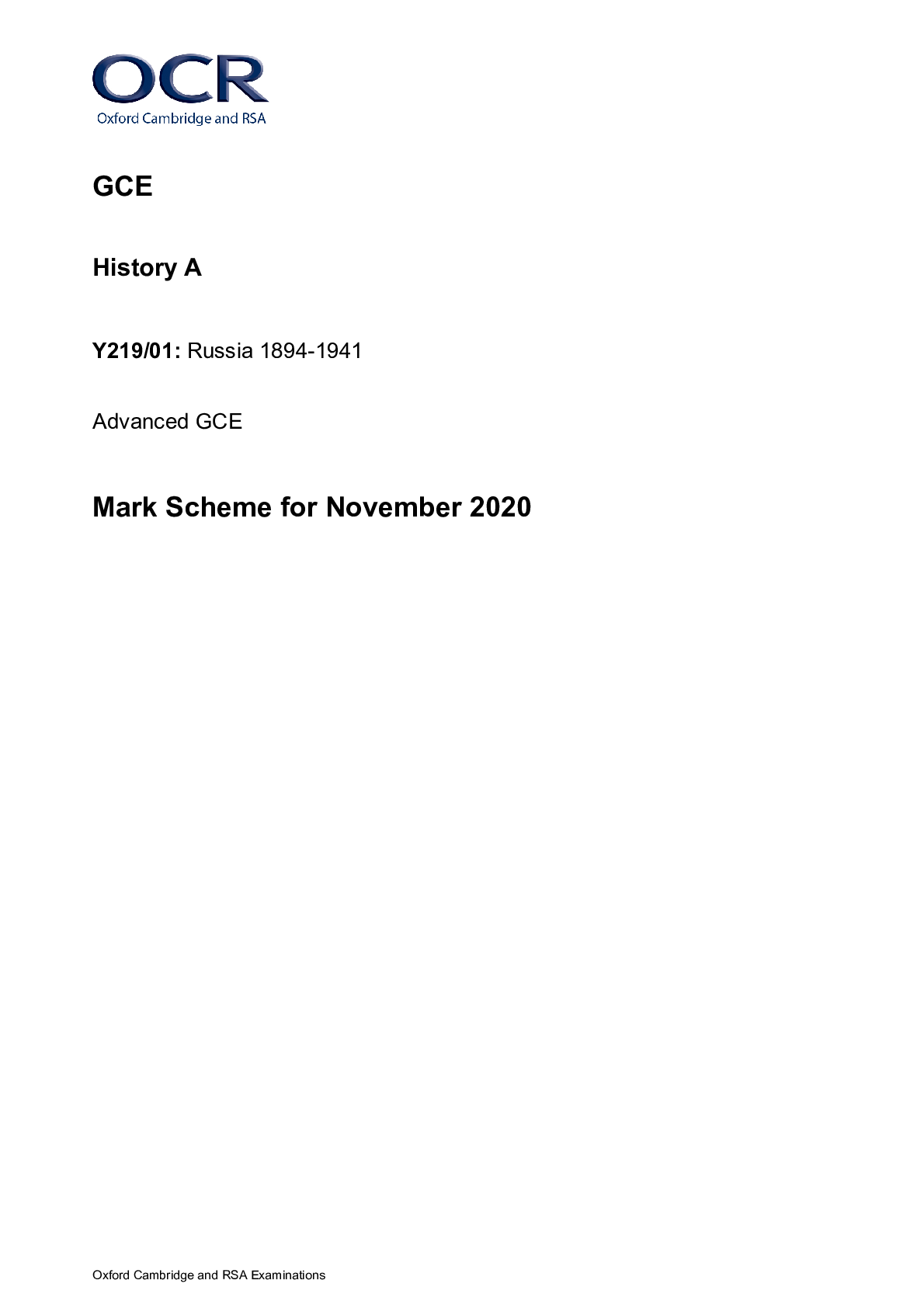
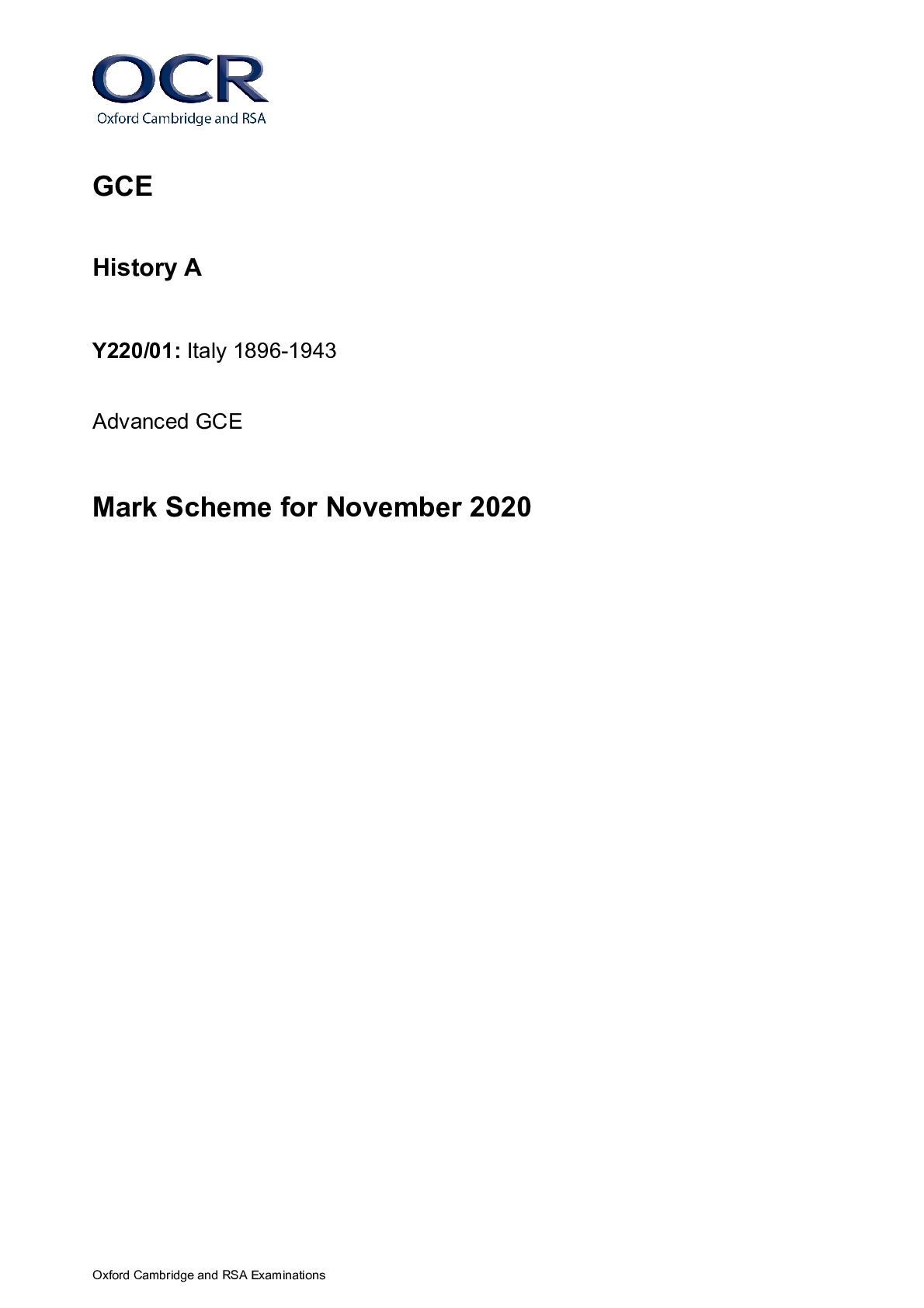

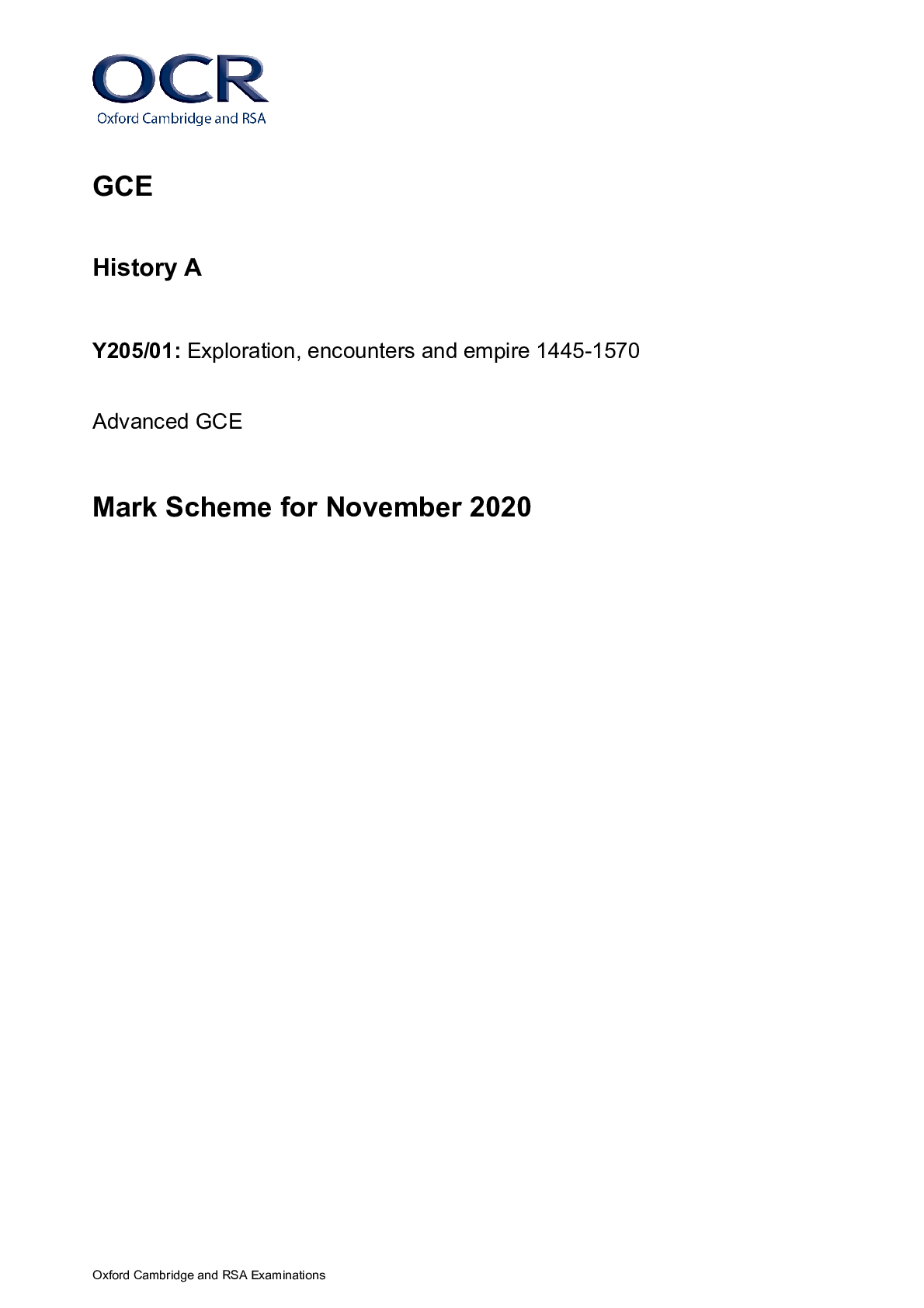
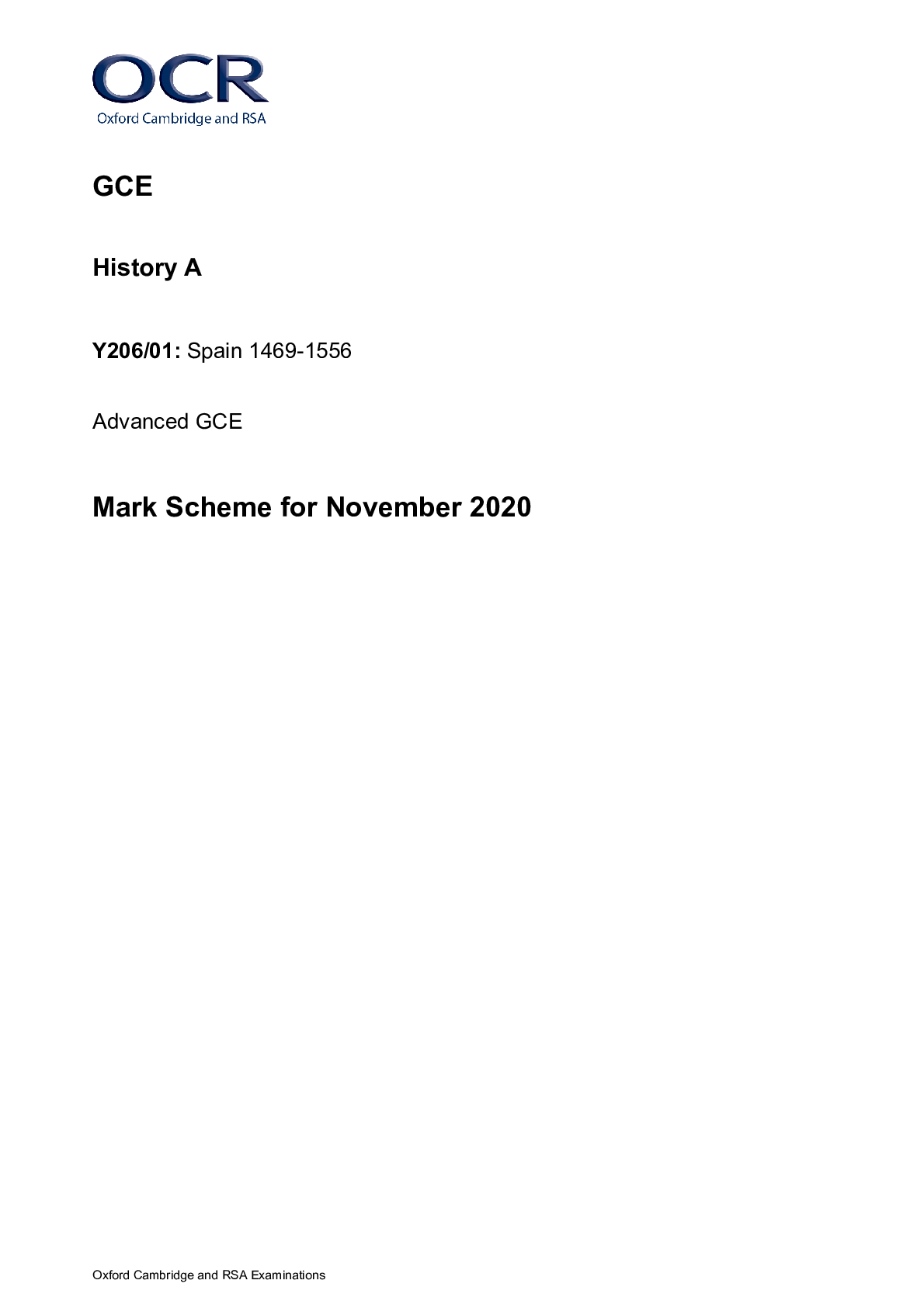
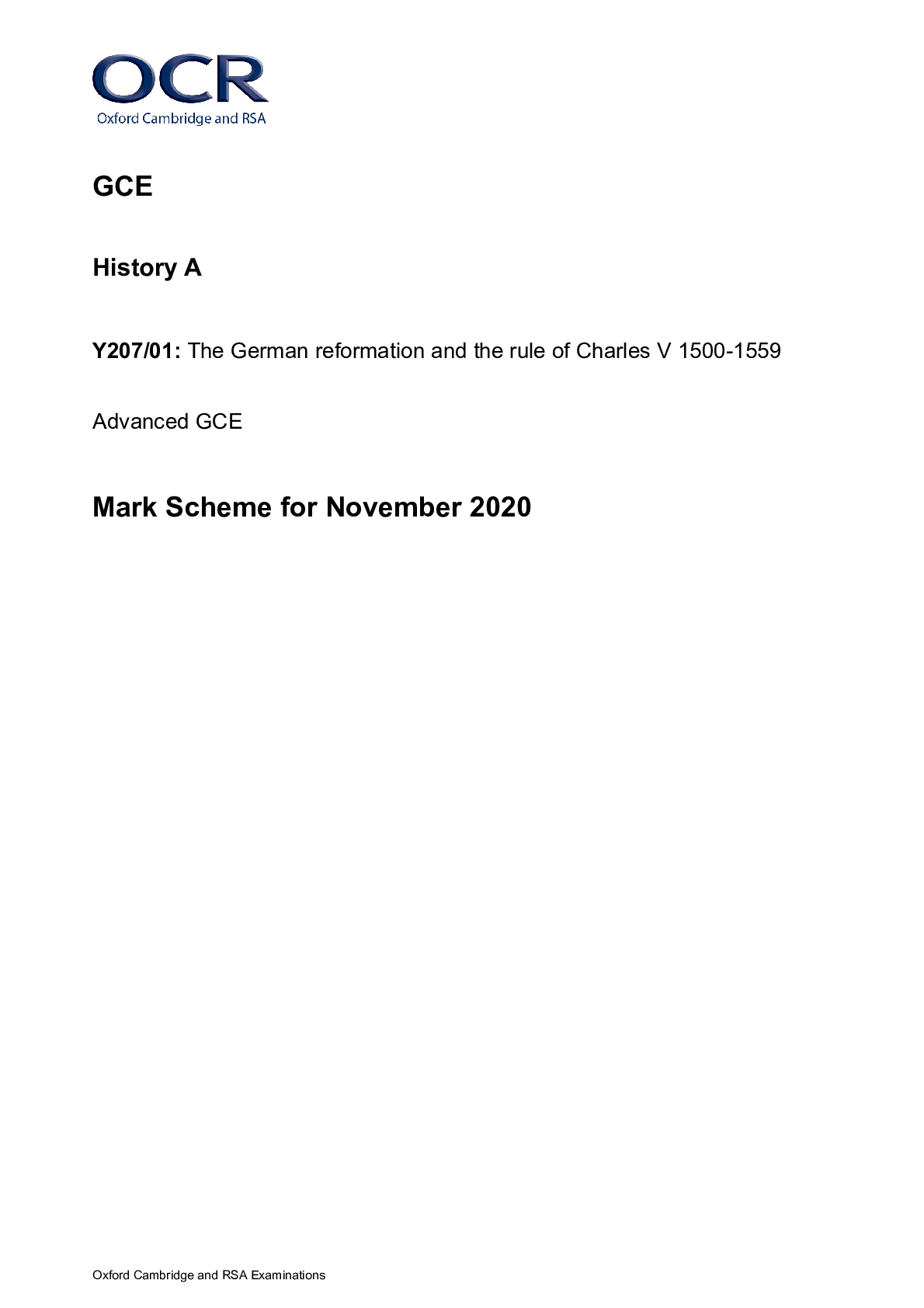
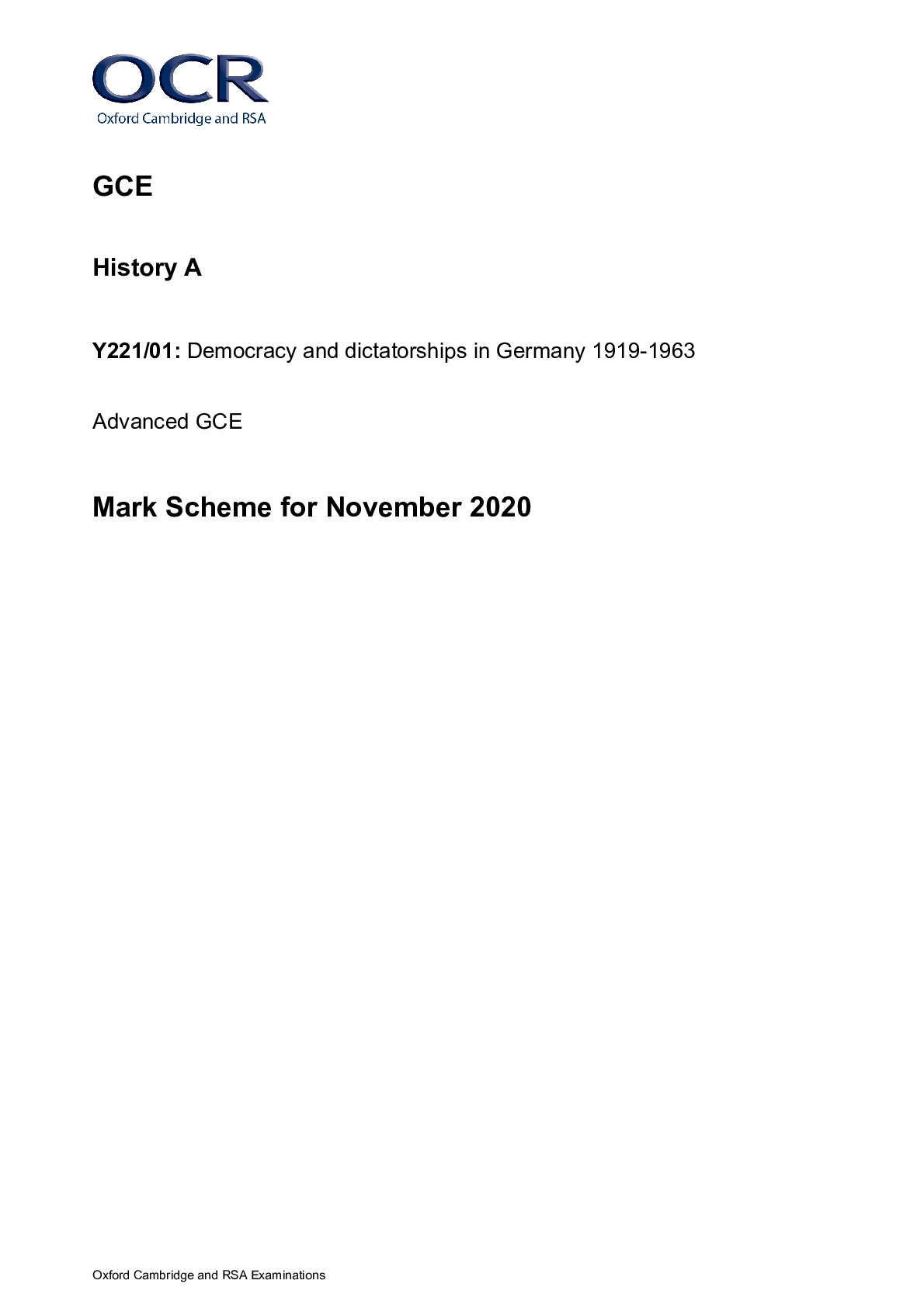

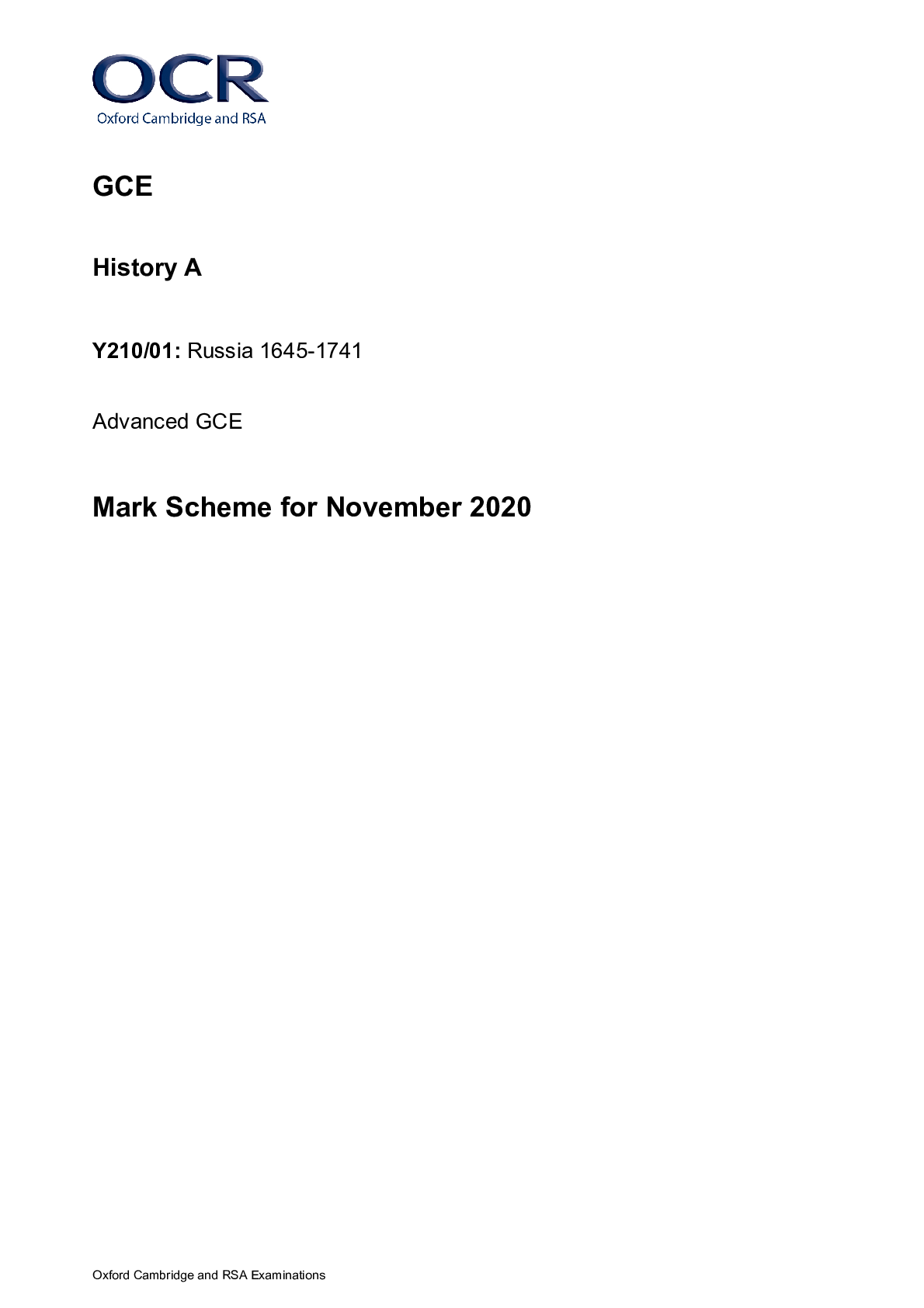


.png)






